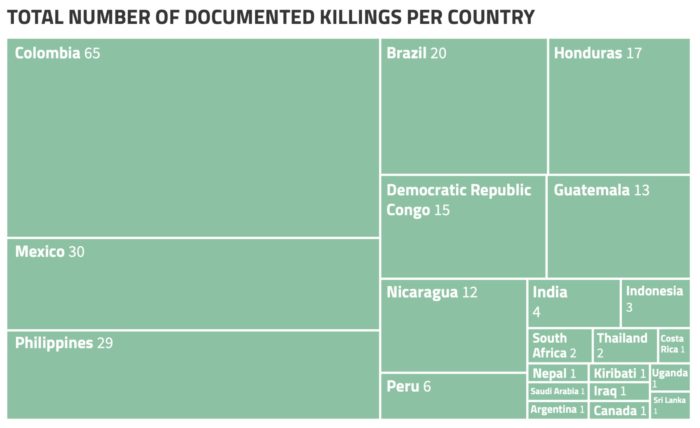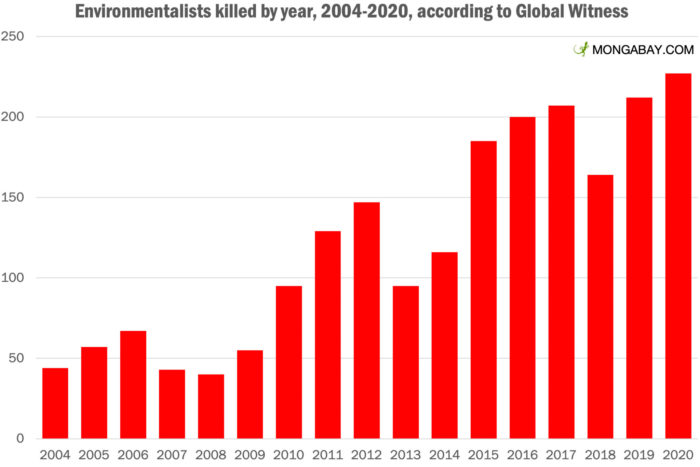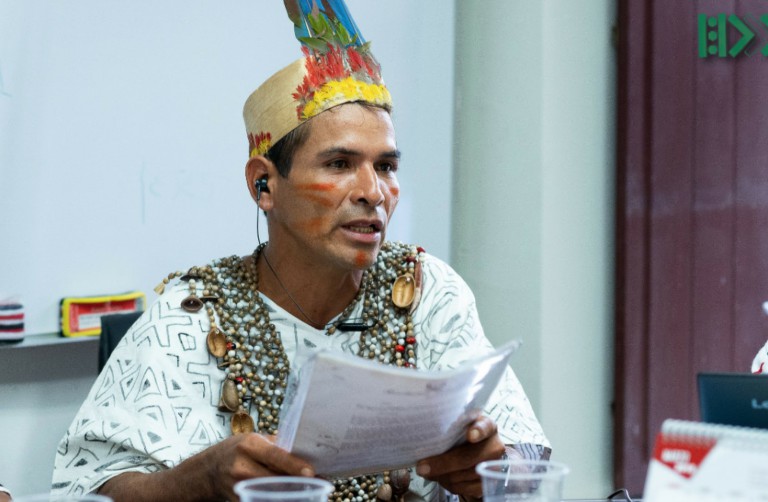This article was first published on 13 September 2021 by Mongabay. You can read the original here.
- The countries with the highest death tolls overall were Colombia, Mexico, the Philippines, Brazil, and the Democratic Republic of Congo.
- Overall, the Americas were the most dangerous for land and environmental defenders, with seven of the top 10 countries by number of killings located in Latin America.
- Nicaragua and Honduras were the deadliest per capita, as threats against Indigenous land by cattle ranchers and economic migrants continue to rise.
- Global Witness said governments need to take more aggressive action to force businesses to monitor and regulate their supply chains.
Despite COVID-19 restrictions and lockdowns, 2020 set a new record for the deadliest year for land and environmental defenders, Global Witness said Sept. 13. It’s the second year in a row that the death toll reported by the advocacy group was the highest since it began tracking data in 2004. In all, the world saw at least 227 killings — a figure described as almost certainly an underestimate.
“During the last decade we’ve seen a grim trend,” Seema Joshi, director of campaigns at Global Witness, said in a press conference. “As the climate crisis intensifies, violence against defenders of the Earth is also escalating.”
The bulk of the killings took place in the Americas, where violence against Indigenous and other communities over land and control of resources are common. Of the top 10 countries by number of deaths, seven were in Latin America.
In Colombia, where 2016’s peace agreement between the government and rebel guerrillas created a power vacuum in areas known for drug routes and coca production, 65 defenders were murdered in 2020 — the highest total of any single country.
According to Global Witness’s research, 17 of those killings were related to a government drive to coax rural farmers into moving from growing coca to other crops. The policy was a key element of the peace deal, but as trafficking groups and security forces clash over its implementation, Indigenous and other rural communities have been caught in the crossfire.
“The international community must raise its voice and demand comprehensive compliance with the Peace Agreement, the advance of mandatory regulatory frameworks for human rights, and substantial progress in the investigation, prosecution, and punishment of attacks committed against human rights defenders,” said Lourdes Castro, coordinator of Programa Somos Defensores in Colombia.
Mexico saw the second-highest total, at 30 dead, more than two-thirds higher than in 2019. Many of the killings were linked to logging operations, with half the death toll occurring in Indigenous communities. Rounding out the top five most deadly countries were the Philippines, Brazil, and the Democratic Republic of Congo, where 12 park rangers were killed in a patrol in Virunga National Park in April 2020.

Overall, a third of the environment and land defenders killed in 2020 were Indigenous. The news comes amid calls for community land titling efforts to play a bigger role in the world’s response to the biodiversity crisis.
“As Indigenous people we see the first step as strengthening self-government and defense of our territory, based on our ancestral knowledge,” Oscar Daza, an Indigenous leader from Colombia’s Korebaju people and coordinator of human rights and peace at the Organización de Pueblos Indígenas de Colombia (OPIAC) told Mongabay. “Our governments must have the political will to legally title our territory, and they should implement national and international regulations that protect the rights of defenders, like the Escazú Agreement and the Pact of Leticia.”
Nicaragua became the most dangerous country for land and environment defenders per capita, as invasions of Indigenous land by cattle ranchers and other migrants have led to clashes and massacres. It was followed by Honduras, where similar threats to Indigenous and other community lands have been recorded. Earlier this year, Mongabay reported on an illegal road being cut through the Río Plátano Biosphere Reserve by cattle ranchers suspected to be linked to narcotrafficking.
“Where reports indicate that defenders were attacked for protecting their ecosystems, the majority — 71% — were working to defend the world’s forests,” Joshi said.
Overall, of cases where assassinations could be linked directly to an extractive project, the logging sector was the deadliest for defenders, at 23 killings. Water defenders and those opposing dams accounted for a further 20 deaths, with mining, extractives, and agribusiness combining to add another 34 people to the toll.
Global Witness said 112 killings were likely connected to land disputes, but the specific economic motive was more difficult to pin down than in past years due to restrictions on movement and travel that made it harder for journalists and investigators to visit remote areas. In some cases, COVID-19 restrictions may have increased the dangers faced by defenders, as lockdowns made it easier for assailants to track the whereabouts of their targets.
Fikile Ntshangase, a South African woman who led protests against the Tendele coal mine, was shot dead in her home by three men in October 2020. The report also highlighted the case of Óscar Eyraud Adams, an activist from Baja California in Mexico who was gunned down at his residence in Tecate after campaigning for greater access to water for Indigenous communities in the region.

All but one of the killings took place in countries in the global south, with the bulk occurring in those classified as having repressive policies on civic discourse. Global Witness said the full death toll for defenders was likely to have been higher, as killings that took place in countries where journalists and civil society investigators are prevented from publicizing attacks could not be included.
Global Witness called for more stringent international regulations on businesses that traffic in or finance commodities like timber and fossil fuels, saying that voluntary reporting and non-binding agreements aren’t doing enough to prevent violence.
Speaking at a press conference accompanying the report’s release, Mary Lawler, the U.N.’s special rapporteur on the situation of human rights defenders, said companies should be thinking about potential violence against local advocates before they start operating.
“When companies fail to do that, and in cases where human rights defenders are subsequently targeted for raising human rights concerns regarding the business project, whether that targeting is carried out by a subsidiary of the parent company with the EU link, or one of its subcontractors or suppliers, there must be accessible paths to accountability through civil and criminal liability,” she said.
This article was updated to include quotes from Programas Somos Defensores and OPIAC in Colombia.
Banner image: Arbildo Meléndez, a Peruvian Cacataibo Indigenous leader, who was murdered on April 21, 2020. Image courtesy of AIDESEP.

